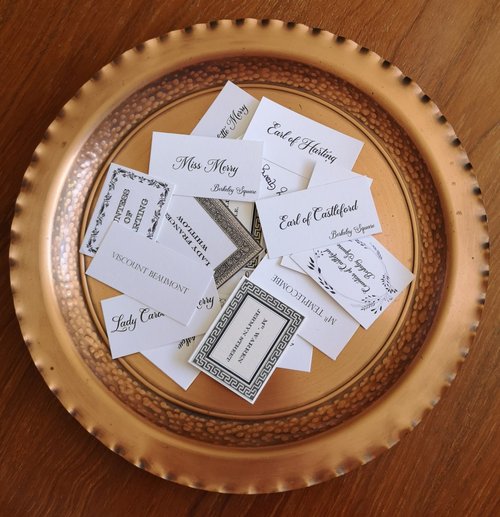In Regency England, the exchange of calling cards was a meticulously choreographed ritual that dictated social interactions. These small, elegantly printed cards were more than just a means of introduction — they were a reflection of one’s status, intentions, and adherence to societal norms. The practice of using calling cards, or visiting cards, was an essential part of the social fabric, governing who could visit whom, when, and under what circumstances.
The Origins of Calling Cards

Calling cards originated in 17th-century Europe, particularly in France, where they were used by aristocrats to announce their arrival at social gatherings. By the Regency era, the practice had become firmly entrenched in British high society. The cards themselves were often made of high-quality paper, embossed with the owner’s name and sometimes a family crest. For women, the cards might also include their husband’s name and title, reflecting their marital status and social standing.
The Etiquette of Exchange

The rules surrounding calling cards were strict and unforgiving. A misstep in etiquette could lead to social ostracism, making the process both a privilege and a minefield. Here are some key aspects of the etiquette:
- Timing: Calls were only made during specific hours, usually in the afternoon. Morning visits were reserved for close friends and family, while evening calls were considered improper.
- Presentation: Cards were presented to the servant at the door, who would then deliver them to the lady of the house. The servant would also note the caller’s name and the time of the visit in a ledger.
- Folding: The corners of the card could be folded to convey specific messages. For example, a folded top-left corner might signify a personal visit, while a folded bottom-right corner could indicate condolences.
Social Implications
The exchange of calling cards was a way to navigate the complex social hierarchy of Regency England. A rejected card could signify social ostracism, while a warmly received one could open doors to prestigious gatherings. The practice also reinforced gender roles, as women were often the gatekeepers of these social interactions. A lady’s ability to manage her calling card list was seen as a reflection of her social acumen and standing.
The Role of the ‘At Home’ Day
One of the most important aspects of calling card etiquette was the concept of the ‘At Home’ day. Ladies of the house would designate specific days when they would be available to receive visitors. These days were often published in social calendars, and failing to adhere to them could result in social embarrassment. The ‘At Home’ day was a way to manage the influx of visitors and ensure that social interactions remained orderly.
The Decline of Calling Cards
As society evolved, the rigid etiquette of calling cards gave way to more informal modes of communication. The rise of the telephone and the increasing pace of life in the late 19th and early 20th centuries made the practice seem outdated. However, their legacy remains in modern business cards and the enduring importance of first impressions.
Conclusion
The art of the calling card offers a fascinating glimpse into the complexities of Regency society. It was a world where even the smallest details — like the fold of a card or the timing of a visit — could have significant social implications. The practice underscores the importance of etiquette and the lengths to which people went to maintain their social standing.
References for Further Reading:

I like reading books about families that way the stories can keep going
I like to read your trivia because I want to learn. If I see, hear or read something and it peaks my interest, I will research it
Thank you for educating me,